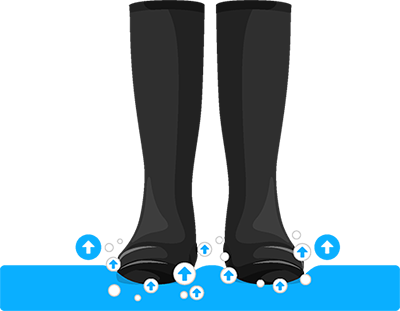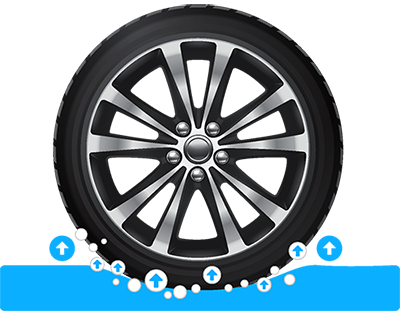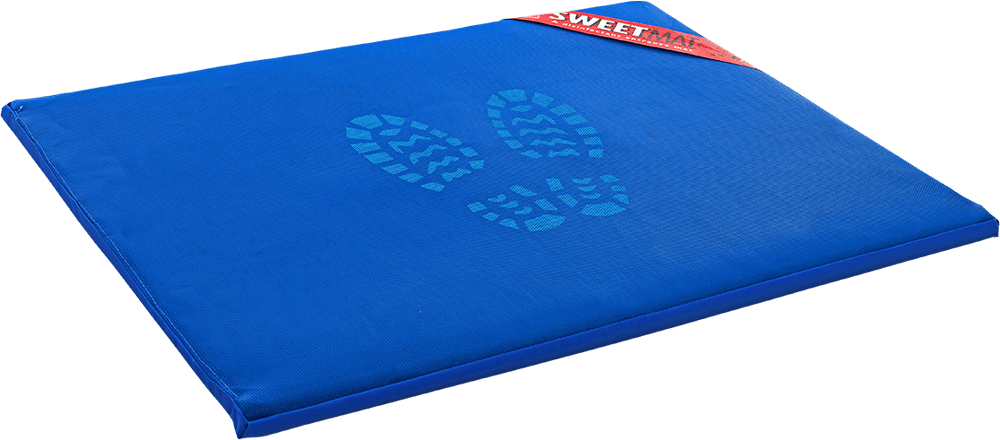The Science Behind Sweetmat
Reduce contamination and disease transmission successfully with a Sweetmat Disinfection Mat.


Our disinfection mats work under hydraulic pressure and as a vehicle or a person moves over the mat, the disinfection solution is pushed up into the tread of the tyre or the footwear. This method ensures thorough sanitisation into all areas of possible contamination.
Sweetmat User Instructions
Set up
- Place mat at the entrance on a smooth, level, stone-free surface
- Ensure that the mat is placed where there is a continuous direction of travel
- Pre-mix the liquid to the required strength
- Pour liquid gently over the mat, a watering can is good for this
- Fill the mat until saturated and liquid appears when you put your foot lightly on the mat
Use
-
Vehicles should drive over the mat at no more than 5 km/h to ensure a 2-second contact time
-
Top up as required and replenish within the effective active time of the disinfectant
-
Fully clean foot mats once a week for best results
Cleaning and storage
-
Roll up the mat to release excess liquid
-
Dispose of contents safely and responsibly
-
Place mat on edge and hose thoroughly, leave to drain, or hang on a rail to dry
-
When not in use store in a dry area
-
The effectiveness of your mat will diminish if left in a dirty state

What Type Of Disinfectant Should I Use In My Disinfection Mat?
Disinfectants are antimicrobial agents that are applied to the surface of non-living objects to destroy micro-organisms present on them. Sweetmat Disinfection Mats provide a universal applicator for a range of agents.
A perfect disinfecting agent would offer complete and full microbiological sterilisation, without harming humans or animals, be inexpensive and non-corrosive. BUT not all disinfectants are suitable for all purposes and you need to make the best choice based on your situation requirements.
Some disinfectants have a wide spectrum action (killing many different types of micro-organisms), while others kill a smaller range of disease-causing micro-organisms but are preferred for other properties (they may be non-corrosive, non-toxic or inexpensive).
Disinfectant Options
| Disinfectant Concentrate % Required to Eliminate Micro-Organisms | Sensitivity | ||||||
| Disinfectant Type | Viruses (Non-enveloped) | Viruses (Enveloped) e.g. Human Corona Virus, African Swine Fever, Common Flu, HIV-1 |
Bacteria e.g. Mycoplasma Bovis, E-coli |
Fungi e.g. Myrtle Rust |
Coccidia Oocysts | Organic Matter | Temp <5 deg C |
| Aldehydes | 1 | 1 | 1 | 1 | - | Low | High |
| Quats | Not Effective | 1 | 1 | 0.1 - 0.5 | - | Medium | Low |
| Aldehydes + Quats | 0.5 - 1 | 1 - 3 | 2 - 4 | 2 - 6 | - | Medium | High |
| Chlorocresols | 4 | 2 | 0.5 | 2 | 3 - 4 | Low | Medium |
| Halogens | 0.2 - 1 | 0.5 - 3 | 1 - 2 | 0.5 - 5 | - | High | - |
Aldehedes
| Disinfectant concentration % required to eliminate Micro-Organisms |
| Viruses (non-enveloped) |
| 1 |
| Viruses (enveloped) |
| 1 |
| Bacteria |
| 1 |
| Fungi |
| 1 |
| Coccidia Oocycsts |
| - |
| Sensitivity |
| Organic Matter |
| Low |
| Temp <5 deg C |
| High |
Quats
| Disinfectant concentration % required to eliminate Micro-Organisms |
| Viruses (non-enveloped) |
| Non Effective |
| Viruses (enveloped) |
| 1 |
| Bacteria |
| 1 |
| Fungi |
| 0.1 - 0.5 |
| Coccidia Oocycsts |
| - |
| Sensitivity |
| Organic Matter |
| Medium |
| Temp <5 deg C |
| Low |
Aldhydes + Quats
| Disinfectant concentration % required to eliminate Micro-Organisms |
| Viruses (non-enveloped) |
| 0.5 - 1 |
| Viruses (enveloped) |
| 1 |
| Bacteria |
| 1 |
| Fungi |
| 2 - 6 |
| Coccidia Oocycsts |
| - |
| Sensitivity |
| Organic Matter |
| Medium |
| Temp <5 deg C |
| High |
Chlorocresols
| Disinfectant concentration % required to eliminate Micro-Organisms |
| Viruses (non-enveloped) |
| 4 |
| Viruses (enveloped) |
| 2 |
| Bacteria |
| 0.5 |
| Fungi |
| 2 |
| Coccidia Oocycsts |
| 3 - 4 |
| Sensitivity |
| Organic Matter |
| Low |
| Temp <5 deg C |
| Medium |
Halogens
| Disinfectant concentration % required to eliminate Micro-Organisms |
| Viruses (non-enveloped) |
| 0.2 - 1 |
| Viruses (enveloped) |
| 0.5 - 3 |
| Bacteria |
| 1 - 2 |
| Fungi |
| 0.5 - 5 |
| Coccidia Oocycsts |
| - |
| Sensitivity |
| Organic Matter |
| High |
| Temp <5 deg C |
| - |
Aldehydes
Mode of action: Acts on proteins by denaturation and on nucleic acids by alkylation. The reaction is irreversible and pH-dependent, working better at alkaline pH and less at neutral or acidic pH.
Advantages: Very effective against most bacteria, viruses and fungi, but not against parasite eggs. Least sensitive to the presence of organic matter. Relatively inexpensive.
Disadvantages: Not effective in low temperatures (<5°C or 41°F). Irritating and pungent odour. Carcinogenic (Formaldehydes) and allergic when in contact with skin.
Quaternary Ammonium (Quats)
This group of compounds is excellent against bacteria and fungi, but not effective against non-enveloped viruses (e.g. Norovirus, Rotavirus etc.) They are Cationic (positively charged ions) detergents and are effective against bacteria and fungi at low concentration of 0.5%.
Mode of action: Structure and function disruption resulting in leakage of cell components and cell death.
Advantages: Strong antimicrobial action. Colourless, odourless, tasteless, and non-toxic. Effective against Gram-positive bacteria, less effective against Gram-negative bacteria. Also destroy fungi, amoebas, and enveloped viruses (e.g. influenza and many animal viruses). Quats are relatively insensitive to low temperature and organic matter.
Disadvantages: Neutralized by soaps and anionic (negatively charged ion) detergents, Pseudomonas strains that are resistant and can grow in presents of Quats are a big problem concern in hospitals.
Aldehydes and Quats
Chlorocresols (Phenolics)
Mode of action: Cross-linking, coagulating, and clumping leads to leakage of cellular components and finally to death of the microbial cell.
Advantages: Very effective in the presence of organic matter. Effective against bacteria, (especially Gram-positive bacteria) and enveloped viruses. Limited toxicity. Typically effective as a deodorizer.
Disadvantages: Poor to limited residual activity. Not effective against sporicidal activity.
Halogens (Oxidizing Disinfectants)
Chlorine (bleach) is the most widely used disinfectant in North America.
Mode of action: They are oxidizing agents and therefore denature proteins and cause the microorganisms death.
Advantages: Inexpensive disinfectant. Active against most pathogens such as viruses, bacteria, moulds, and algae, but not bacterial spores.
Disadvantages: They are rapidly inactivated in the presence of organic matter. Disinfection efficiency is temperature dependent (at close to 0°C or 32°F disinfection efficiency is very poor). Corrosive to stainless steel surfaces. Frequent refreshing is required.
How Often Should I Change The Disinfecting Agent?
Each situation is different, but you need to consider the following factors:
- Amount of traffic
- Amount of organic matter
- Type of disinfectant
- Dilution rate if outdoors
- Amount of sunlight
- Water quality to begin with
- Ambient temperature
- pH-level
- Presence of other chemicals (soaps, detergents or other)
- Type of micro-organisms you are targeting
To maintain effective biosecurity using a Disinfection Mat you must ensure that the disinfectant you use is regularly checked and maintained.